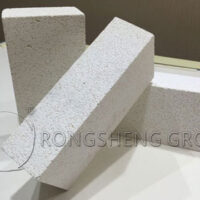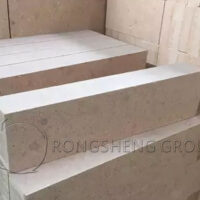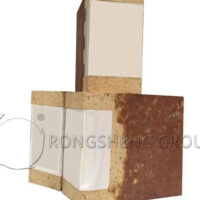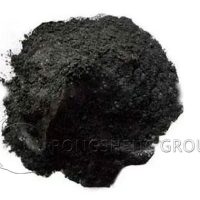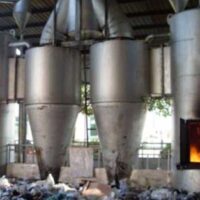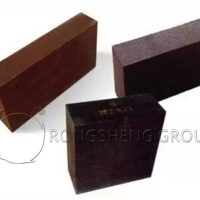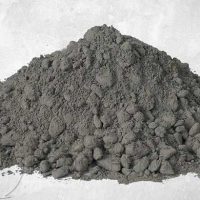The best particle ratio range for sintered magnesia bricks. Production practice shows that expanding the critical particle size of sintered magnesia from 2mm to 3mm will improve the molding performance of the material and the thermal shock stability of the product. Therefore, the particle part in the particle composition, that is, the 3~0.5mm part, is controlled at 30~50%, and it is appropriate to be close to 50%. Among them, the particle size of 3~2mm is preferably controlled at 18~20%.
The fine powder part in the batch, that is, the <0.088mm part, is generally controlled at 35~42%.
The intermediate particles in the batch can improve the room temperature strength and high temperature strength of the product and reduce the porosity. The intermediate particles are generally controlled at about 10%.
The particle composition of the batch should be determined based on the specific production conditions, the sintering degree of the raw materials, the molding pressure, the firing temperature and other process parameters. The fluctuation range of the particle ratio of each level can be appropriately relaxed if the sintering degree is good, the molding pressure is large, and the firing temperature is high. In addition, an appropriate amount of waste bricks or fired waste products of the same type can be added to the ingredients.

Preparation of Clay for Sintered Magnesia Bricks
Place the sintered magnesia sand crushed to meet the particle size requirements in a wet mill according to the proportion of ingredients, add sulfite pulp waste liquid with a density of 1.2~1.22g/cm3 as a binder, and the addition amount is 3~4%. Then add magnesia fine powder and mix for 15~30min. Generally, the moisture content of the mud is controlled at 2~3%. Sometimes MgCl2 can also be used as a binder. When MgCl2 is used as a binder, the strength of the green body after drying is very high.
If the CaO content in the raw material is high, it must be trapped. The trapping temperature is 10~20℃, and the trapping time is 3~4d.
Molding Magnesia Brick Blanks
Molding magnesia bricks should be carried out under high pressure. Usually, a friction brick press with a capacity of more than 300t is used for molding, and the volume density of the brick blank is controlled at 2.90~3.00g/cm3. Hydraulic presses can also be used for molding.
Key points of molding operation: put the clay into the mold, spread the material evenly, flatten the four corners, and start pressurizing. Start with light pressure and then heavy pressure. The number of pressurization varies depending on the size and shape of the brick, usually 3 to 12 times. In production, the volume density of the brick is usually controlled by controlling the unit weight and external dimensions of the brick.
Drying and Firing of Fired Magnesia Bricks
The drying temperature of magnesia brick blanks should not be too high, generally below 120℃. Drying is usually carried out in a tunnel dryer. The hot air inlet temperature is 100~150℃, the outlet temperature is 60~90℃, and the residual moisture is controlled at 1.5~0.6%.
Firing should be carried out in a weak oxidizing atmosphere. At the low temperature stage, the removal of structural water is accompanied by a volume effect, which can cause cracks in the blank, so the heating rate should not be too fast. After 1300℃, the liquid phase begins to appear, the strength increases, and the heating rate can be accelerated. When approaching the firing temperature (1550~1600℃), the liquid phase increases, the strength decreases, and the heating rate should be slowed down.
During the cooling process, the temperature can be quickly reduced before the blank solidifies. After solidification, the “plasticity” of the blank disappears. To avoid cracks, the cooling rate should be properly controlled. The temperature can be quickly reduced below 800℃.
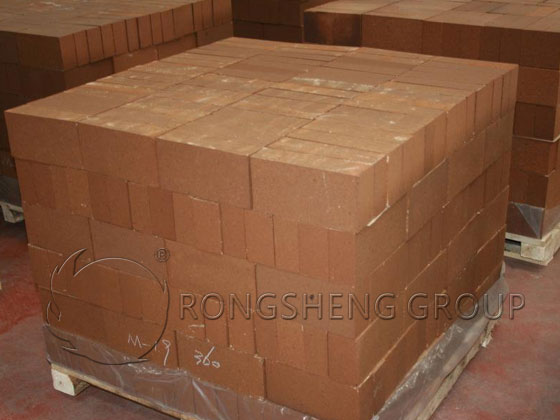
Characteristics of Magnesia Bricks
Magnesia bricks can generally be divided into two categories: sintered magnesia bricks (also known as fired magnesia bricks) and chemically bonded magnesia bricks (also known as unfired magnesia bricks). Magnesia bricks with high purity and firing temperature are called directly bonded magnesia bricks because the periclase grains are in direct contact. Bricks made of fused magnesia sand are called fused rebonded magnesia bricks. Alkaline refractory products with periclase as the main crystal phase. The products have the characteristics of high high-temperature mechanical strength, good slag resistance, strong corrosion resistance, and stable volume at high temperatures.
Magnesia bricks have high refractoriness, good alkaline slag resistance, high load softening start temperature, but poor thermal shock resistance.
Sintered magnesia bricks are made of brick-making magnesia bricks. After crushing, batching, mixing, and molding, they are fired at a high temperature of 1550-1600℃. The firing temperature of high-purity products is above 1750℃.
Unburned magnesia bricks are made by adding appropriate chemical binders to magnesia sand, mixing, molding and drying. They are mainly used for basic steelmaking open-hearth furnaces, electric furnace bottoms and walls, permanent linings of oxygen converters, non-ferrous metal smelting furnaces, high-temperature tunnel kilns and cement rotary kiln linings, heating furnace bottoms and walls, glass kiln regenerator checker bricks, etc.
What Grade of Magnesia Bricks Should be Selected for the Lining of the Submerged Arc Furnace?
The submerged arc furnace is the main smelting equipment for producing ferroalloy products. It uses the energy and current of the arc to generate energy through the resistance in the furnace to melt the metal. The smelting process is mostly carried out in an alkaline environment, and magnesia bricks are usually selected as the furnace lining. In the complex environment of high temperature, erosion and heat loss, the damage of the furnace lining increases energy consumption and production costs. Therefore, choosing a reasonable refractory configuration and optimizing the lining structure are important directions for energy saving in submerged arc furnaces. Especially in recent years, with the decline in output in the steel industry, the non-ferrous industry has not been disturbed, especially the demand for ferroalloys has increased year by year. Therefore, the demand for magnesia refractory materials for submerged arc furnaces has also increased year by year. The performance of the 95 magnesia bricks of Rongsheng Refractory Factory can meet the use requirements of the working layer of the submerged arc furnace. Contact Rongsheng for free samples and quotations.

